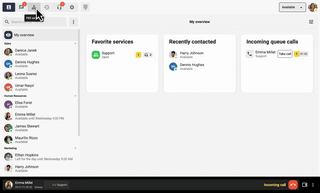Since the World Health Organization (WHO) announced the discovery of an unknown virus in Hubei Province, China, nothing has changed. Businesses have had to adapt quickly and many people are now working from home. You could almost say that the coronavirus has kick-started the world’s biggest workplace experiment.
Introduction
Telavox are experts in business communication with the aim of making work life more fun and productive with the right digital tools. In collaboration with organizational expert Johanna Olsson from the agency The Hows, we guide you through how to create the best conditions for your team to collaborate remotely. We tell you which digital tools make work easier and share strategic tips on what you as an entrepreneur should think about now – and after the corona crisis.

How to create a positive company culture with a remote team
When we work remotely, many of the needs we have as human beings in a work environment are heightened. We need security, belonging and to feel competent. This becomes more difficult when we work remotely. It’s easier to feel disconnected from the social aspects of work when we have a deficit of natural social meeting places at work, such as lunch, coffee breaks or when we run into each other before a meeting. We also feel less confident about what is happening in projects and in the company in general when we no longer get the same overview and can communicate as when we meet in person.
Anxiety can overtake the will to cooperate
At the same time, the way we work can also feel new and alien. We may start to question our personal competence, which can lead, among other things, to a loss of motivation and feelings of depression. We feel a greater need to assert ourselves and prove ourselves. This in turn takes over the willingness to cooperate. We may start directing each other to regain a sense of control. We may react in ways that may seem very strange. But it is actually quite natural and linked to basic human needs.
The importance of meeting basic needs
When we are going through a crisis, we can get better at ramping up the things that help us meet basic needs. For example, we are increasingly seeing teams making an effort with digital coffee breaks and AWs to increase the sense of belonging.

7 tips on how to keep a remote team together
As an employer, it is important that you are clear about expectations and create good structures. The relational tools such as feedback processes, relationship-building habits and continuous work on building security and openness in the team, are at least as important.
1. create or develop your business values
When a team works remotely, it is more difficult for new team members to understand and get into the company culture because you hardly meet physically. Therefore, it is important that you communicate and document the kind of values that should permeate and guide employees in their daily work. There should be a clearly articulated company culture for everyone in the organization, new and old, from day one.
For the positive company culture to continue to grow, especially with a geographically dispersed team, you need to constantly evaluate the company culture. Talk a lot about values with your employees. What values are most important to them? Are there any values that have changed over time?
2. Tell others about your culture
From an employer brand point of view, it is brilliant to publicly publish your company values and how you reason about them. This will attract the right talent and also make it easier for new employees to understand and get into the culture – especially for those who work remotely.
Netflix is a well-known example of a company that openly shares its corporate culture. Netflix Culture: Freedom & Responsibility was published by Reed Hastings, Netflix’s CEO and founder back in 2009 and has almost 20 million views.
3.Welcoming new employees in front of the whole team and company
When you’re new to a company, you’ll usually be given a tour and introduced to your colleagues. This is not as easy if you work remotely. But it can be solved quite easily. At Telavox, we use an internal chat where we have created different open chat rooms. One chat room is called “New at Telavox”, where new employees can create a post and write a few lines about themselves. Then everyone at the company knows that they have a new colleague. It is of course also possible to send out the information via email.
Encourage new employees to schedule meetings with team members and colleagues in other departments with whom they will be working closely. These coworkers also help spread the company culture and it’s a great way to get to know each other on a more personal level.
4. encourage an environment of open communication and feedback
Create clear, simple and open communication channels. This promotes transparency and encourages employees to get in touch with each other. At Telavox, we use internal chat extensively, it has even almost replaced email. Chat lowers the communication threshold between employees, you get faster responses and it reduces email spam. As a leader, you should encourage an environment where everyone contributes in your team. Through chat, it’s not just the loud and extroverted who take up space, but everyone feels comfortable expressing themselves. The aim is to reduce bureaucracy and formalities as much as possible to avoid silencing employees, which is never healthy or conducive to creativity.
The internal chat on Telavox is also a great tool for onboarding new employees. The chat contains all employees’ contact details, which department they belong to, which country they work in and a picture of the person. If you’re new to the job, this gives you a valuable overview of the people in the company and also how it is organizationally structured. Here, a Telavox employee explains how he quickly got into the team with the help of the communication platform.

5. Set expectations on communication methods
It is important to be clear about how, when and for what your communication channels will be used. You may want to handle more formal documentation via email while more casual communication is done via Slack or Skype.
An internal guide can help you reduce confusion about what and where team members should post. If your team uses different communication tools to collaborate (such as Microsoft teams for file sharing or Slack for chat), let all team members know right away.
6. Keep the communication alive!
Communication will be crucial to your success or failure in staying together as a remote team. Therefore, set aside regular weekly check-ins – try to have at least two meetings. Review what the team is working on, provide information on any decisions that may affect the team and encourage feedback and open dialog. In addition, try to hold the meetings by videoconference. This allows people to recognize each other and see reactions and facial expressions. Body language contributes to more effective communication as people observe your body language almost as much as they listen to what you say.
7. Show clearly when you work and when you are free
Are you in a meeting? Taking a nap? Or are you at yoga? It’s not easy to keep track of each other when you’re a remote team. There are different ways to account for where you are, for example by having an open calendar or communicating via email. In the Telavox app there is a “Profiles” setting. There you can easily let colleagues and customers know if you are at lunch, sick, etc. You can choose which number is displayed to the outside world, and set which calls should be received – direct calls or queued calls.
Summary: How to build company culture when working remotely
- Create or develop your business values.
- Tell others about your culture.
- Welcome new employees in front of the whole company.
- Encourage an environment of open communication and feedback.
- Set expectations on communication methods.
- Communicate, communicate, communicate!

